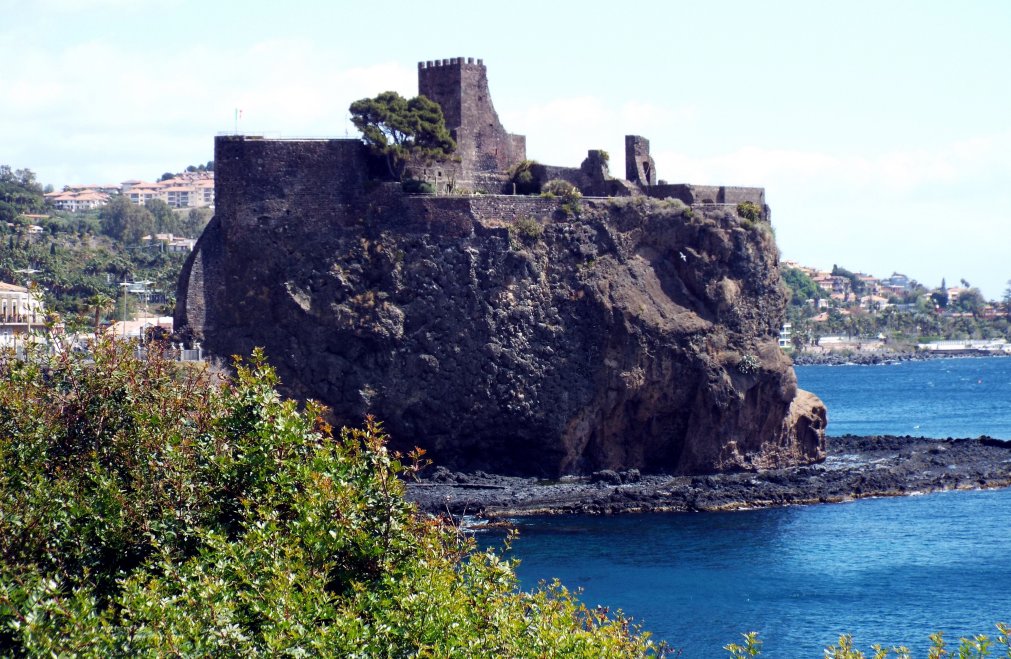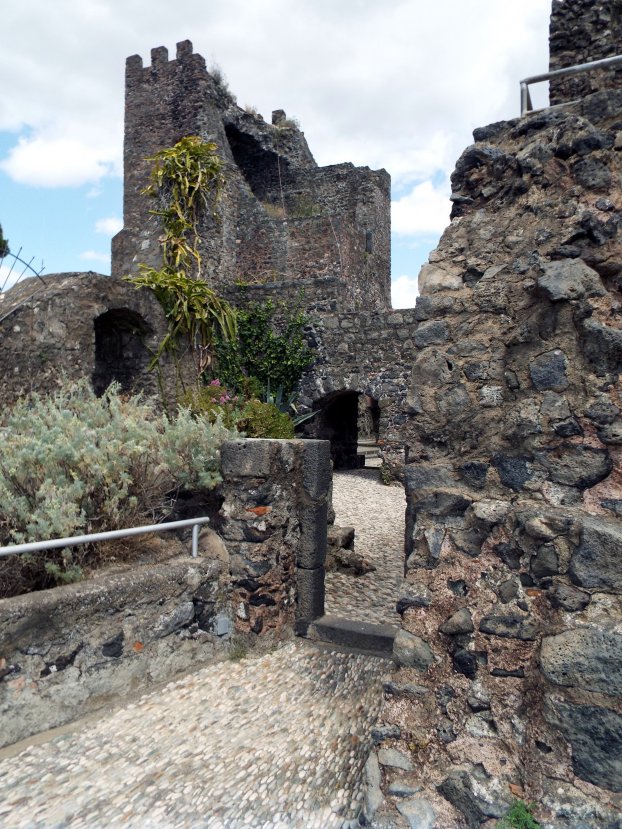Aci

The fortress was destroyed and then rebuilt by King
Tancred (d.1194) when he seized the throne in 1189. It later became the
property of the bishops of Catania until 1221 when Bishop Walter
Palearia was removed from his post by Frederick II (d.1250). In
1239 Frederick officially took over the castle in recompense for
liquidating the bishop's debts even though he had died as long ago as
1229.
After the 1266 Angevin occupation of Sicily, the castle
was returned to the bishops in 1268, but seized again by the Crown after the
Sicilian Vespers of 1282. It was soon given to Roger Lauria (d.1305), the admiral of
the Aragonese fleet who had received Tripi before 1285, for in 1296 he transferred his loyalties to the Angevins on the accession of Frederick III (d.1337).
Consequently Aci castle was besieged and captured in 1297 by King
Frederick and Lauria was stripped of his fiefs. The
siege was hard pressed and involved the king having a siege tower
constructed called ‘cicogna'. This overawed the garrison and
allowed a drawbridge to be dropped down onto the battlements for a successful
assault. When peace was made at the treaty of Caltabellotta in 1302, Roger submitted to Frederick and received his estates back.
In 1320 the castle was taken from Margaret Lauria,
and given to Blasco Alagona (d.1385). Whilst the latter was away
defending Palermo
from the attacking Angevins, Bertrando di Balzo
sacked Aci in his absence. The great eruption of Mt Etna in 1329
heavily damaged the district while Blasco was still lord. This
was witnessed by Nicholas Speciale on 28 June.
... as the sun was setting in
the west, Mount Etna shook violently in horrific upheaval and roared...
from the eastern face of the mountain... where white clouds hitherto
could always be seen, the earth was suddenly ripped away and fire burst
forth vehemently... and globs of molten rock belched forth with a
horrible din.... All along the eastern and southern sides...
where many ancient buildings had stood for those seeking solitary
worship of God, the powerful and ceaseless shaking of the earth either
destroyed them outright or left them broken and shattered and the earth
itself opened so wide as to swallow whole streams that had flowed by
peacefully. Along the nearer coastline many boats and skiffs
which had just recently docked, sank on account of the countless
quakings of the land beneath the sea.
Finally there was an eclipse on 17 July 1329 after which he:
beheld thousands of flaming
rocks that had been blown from the mountain, a terrific earthquake
shook the whole land and the ground ripped open on this and
that... Lava divided into 3 main streams, 2 of which ran
eastward, bringing great slaughter throughout the district of Aci... while
the third ran headlong to the limits of Catania.
In 1354 the castle was severely damaged and taken
by Marshal Aciaiolu, who had been sent to Sicily
by
Duke Louis I Anjou of Naples (1339-84). As a consequence Artale Alagona (d.1419),
the son and heir of Blasco, defeated the Angevin fleet in the bay and
retook the fortress for King Louis, who may have granted it to
Frederick Randazzo who died soon after. After returning from his
abortive attack on Palermo, King Louis retired to the castle where he
died, probably of the plague on 16 October 1355. The castle then reverted to Artale.
In 1396, during the absence of Artale, the troops of King Martin I took
the castle by poisoning its water supply. Subsequently they set fire to
the castle before Artale arrived with a relief army. Later Martin restored the castle and after 1402, was occasionally in residence there with his second wife, Queen
Bianca (d.1441). After his death in 1409, Queen Bianca moved
to Paterno castle and gave Aci to Ferdinand the Just of Castile
(d.1416), who became the new king of Sicily in 1412.
In 1416 the first viceroy of Sicily, Giovanni di Castiglia, ordered the
renovation the castle. The fortress was presumably brought up to
scratch and in 1421, the Viceroy Ferdinando Velasquez became lord of
the fief of Aci, by paying King Alfonso (d.1458) 10,000 florins.
When Velasquez died, the castle reverted to the king, who again sold
it, this time to his secretary Giambattista Platamone. King
Alfonso's brother and successor, John II of Aragon (d.1479), demanded
possession of the castle from Sancho, the descendant of
Platamone. Sancho refused and the castle was besieged and soon
taken, Sancho and his son being imprisoned in Ursino castle in
Catania, where they both died.
The castle remained in royal hands and in 1634 King Philip III (d.1665)
equipped the castle with artillery and had a marble plaque affixed to
the entrance with the words:
PHILIPPUS III REX HISPANIARUM ET INDIARUM ET UTRIUSQUE SICILIAE ANNO DIVI 1634.
Even so the old castle must have been reaching the end of its useful
life and was not really suitable as an artillery fort. The castle
was badly damaged by the earthquake that devastated eastern Sicily in
1693, although some repairs were undertaken. In 1818 another
earthquake caused such serious damage to the castle that it was
abandoned, even as the prison which it had become.
Description
The castle is set on a basalt rock jutting out to sea and consists of a
small rectangular keep and 2 wards to east and west. The land ward is a
jutting spur or eperon, walled around the cliff top like a ship's
prow. Although more common on rocky sites in the south of France like Peyrepertuse or Cabaret, another eperon can be found at Sperlinga. Access to the Aci prow is currently gained only via the keep.
This stands in the centre of the rock, commanding the entrance steps up
the north side of the rock to a rectangular gatetower at the northeast end of
the site. This is reached via rock cut steps running east up the
face of the rock. The projecting rectangular gatetower that was
once equipped with a drawbridge, although the facing and the Romanesque
arches all appear to be modern replacements. The face of the outer gateway is
definitively eighteenth century, although it bears some resemblance to that found at Sperlinga. Through the Aci gate passageway the
steps dog leg up the rock face and enter the east bailey beneath the
keep. From here access can be gained to the undercrofts of the
buildings that lay along the east curtain, safest from the land
side. The arches within the undercroft are ogival.
The keep, set on the north side of the enclosure, is a small nearly
square tower, which has two vaulted storeys and a basement. The
structure has been much rebuilt and has doorways to east and west to allow
access to the two wards. To the west the tower is stepped, but
not apparently on the other 3 sides. A later vault has been
inserted at roof level giving the tower a solid fighting top,
presumably for artillery. The basement vaulting is ogival and the
only apparent light is on first floor level to the north. However
the rebuilding of the remains could well have filled any such
apertures. The much destroyed tower at Caccamo may have been similar, as too may have been the keep at Milazzo.
A similar tower to Aci keep lay to the south, but this is even more
ruined to the extent that only the basement and a first floor doorway
have survived. That doorway though, is typically
‘Byzantine' with a tiled Romanesque arch and flat lintel
beneath. Other such doorways survive at Calatabiano and Rometta. Beneath the keep to the south is another chamber with
ogival vaults, which has been heavily rebuilt. Much ‘Roman'
tile is to be found built into the walls, while many cisterns are cut
into the rock beneath the castle. Similar supposedly Byzantine castles may exist at Agira, Belvedere, Brolo, Calatabianco, Calatamauro, Calatubo, Caltavuturo, Caltanissetta, Castelmola, Castronovo, Cefala Diana,
Cefalu, Cerami, Erice, Francavilla, Gagliano Castelferrato, Geraci Siculo, Milazzo, Mistretta, Modica, Nicosia, Pentefur, Rometta, San Marco d'Alunzio, Santa Lucia del Mela, Santapau, Sperlinga, Taormina, Torremuzza, Tripi and Vicari.
Why not join me here and at other Sicilian
castles? Information on this and other tours can be found at Scholarly
Sojourns.
Copyright©2019
Paul Martin Remfry


